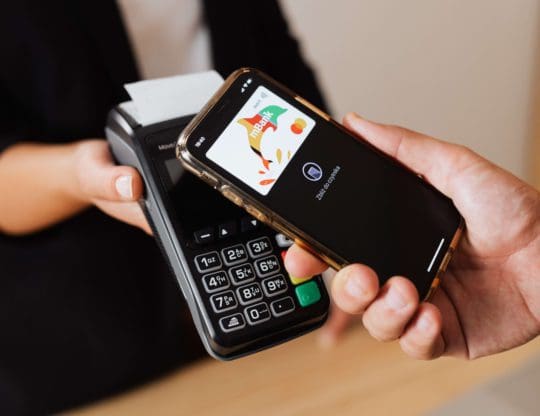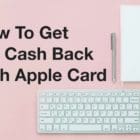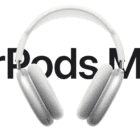Apple’s credit card is nearly two years old, which means it’s the perfect time for an Apple Card review!
Ok, so I may be a little late to the party. But I have been using the Apple Card since it launched. I was given early access to it and made it my first-ever credit card.
Since using it, I’ve increased my credit limit twice, built my score up from nothing to over 700, and have earned over $200 in cashback (about $10/month). I’ve used it to finance Apple purchases, rectify errant purchases, and I’ve even started using other credit cards over that time, too.
In other words, I like to think I have a pretty solid understanding of Apple Card. Not only as a techie and personal finance student but also as a dedicated user.
So today, I’m going to give you the best Apple Card review I can. I’ll go over the good and the bad, the competition, and those who will be able to get the most out of it.
Without further ado, let’s get into it!
Contents
Apple Card review: The basics
To kick things off, I figured we discuss the basics. These are what I see as being the fundamentals of Apple Card. If you don’t read anything else in this post, read this section!
Apple Card fees and interest
The first two things anyone should look into before getting a new credit card are the fees and interest. This matters because if a credit card’s fees outweigh what you’re going to earn by using it, then you probably shouldn’t get it. I’m a pretty light spender, so I only get back about $150 in cashback on all my cards combined. A card with a $200 annual fee would be worse than sticking to debit.
So what are the fees on Apple Card? Nothing!
Yep, I’m pleased to start my Apple Card review by letting you know that Apple Card doesn’t charge any fees. There are no fees to sign up or continue using it. There also aren’t any fees for installment plans on this card – but more on that in a minute.
If you miss a payment, however, you are going to be hit by interest, just like any other credit card. I’ve found Apple to be pretty forgiving in this area though; it set up lots of generous forgiveness policies at the beginning of COVID that were super easy to enroll in.
Interest will vary depending on your credit score when you apply. I didn’t have a credit score when I signed up for Apple Card and my current interest rate two years later is 21.999%.
The rewards you get with Apple Card
This will be one of the shortest parts of this Apple Card review. Apple Card has a super simple rewards program. It looks like this:
- 1% cashback on all purchases made with the physical Apple Card
- 2% cashback on all purchases using the Apple Card with Apple Pay
- 3% cashback on all purchases made to Apple using the Apple Card with Apple Pay
- 3% cashback at select businesses using the Apple Card with Apple Pay (you can find a complete list of these businesses here)
Apple calls its cashback rewards “Daily Cash”. It adds cash to your Apple Cash card in the Wallet app every time a purchase changes from “Pending” to posted. This usually takes one day on weekdays and halts over the weekend.
You can use your Daily Cash whenever you use Apple Pay, transfer it to your bank for free, or if you’re like me, you can use it to help pay off your Apple Card balance.
Buy Apple products on an installment plan with Apple Card
I mentioned this briefly earlier in this Apple Card review. You can buy Apple products with an installment plan by using Apple Card. I did this when I purchased the Apple Watch SE last September. It was $300, so Apple blocked off $300 of my Apple Card balance and releases about $12 back at the end of each month. That $12 is added to my balance for that month, and I pay it off over the next month.

This made a big purchase like the Apple Watch less intimidating, and it’s even more helpful for larger purchases. You can use this feature to buy MacBooks, an iMac, AirPods, iPad, iPhone, etc.
Just bear in mind that your Apple Card limit has to be greater than your purchase. You can’t buy a $1,000 MacBook if you only have $500 available on your Apple Card. And if you have $1,200 on your Apple Card, buying a $1,000 MacBook with an installment plan will shrink your Apple Card limit to $200. It’ll increase slightly each month, but it’s important to know nonetheless.
Managing your Apple Card balance
Oddly enough, I think this is the highlight of my Apple Card review. Managing your balance on the Apple Card is exceptionally simple and clear. I’ve heard people say that plenty of other apps make it easy to pay your credit off on mobile. However, my experience has been that none are as streamlined or straightforward as Apple Card.
You manage your Apple Card balance from the Wallet app by tapping on Apple Card. There, you can see exactly what you owe by the end of the month, your current balance, your available balance, what your interest will be depending on what you pay, all of your transactions, the ability to contact Apple Card Support – everything is right there.
The best part about this is the simple language Apple Card uses. There’s no ambiguity about what you’re supposed to pay, when, and what the consequences will be if you don’t pay. I have other cards that use more vague terms, making it hard to know what you have to pay versus what you can pay.
If you’re new to credit cards, this feature makes Apple Card a great starter.
Unique features of the Apple Card
There are a few other features of this credit card that I wanted to mention briefly in this Apple Card review.
First, Apple Card is made of titanium. It’s a metal card. It gets odd looks now and then, especially at launch back in 2019. Also, the placement of the stripe on the card is the reverse of every other card, which always confuses cashiers.
Secondly, the activation process. Activating your Apple Card is similar to activating AirTags or AirPods. You hold your iPhone near the postcard that your Apple Card arrives in. That’ll launch an animation on your iPhone that walks you through the activation process.
Third, Apple Card can now be shared between family members! I wrote a whole post on this last week, which covers everything you need to know. The gist is that you can add children, adults, and partners to your Apple Card. This means you can share your balance and grow your credit together.
Apple Card review: What’s missing?
Of course, it’s not all good news in this Apple Card review. There are a few areas where the Apple Card is lacking. Let’s cover that real quick.
A sign-up bonus
Apple doesn’t and has never offered a sign-up bonus for Apple Card. If you’ve never had a credit card before, that might not sound like a big deal. However, sign-up bonuses are a big part of credit card culture. Lots of people choose credit cards because they offer a better sign-up bonus over an alternative.
I would guess that Apple hasn’t offered a sign-up bonus because they haven’t needed to. The Apple Card is probably popular enough without one. So why give away the extra cash?
At the time of writing this Apple Card review, I can’t imagine Apple ever offering a sign-up reward for this card. I can, however, see certain sales and deals being exclusive to Apple Card users. For instance, a Cyber Monday sale might be limited to Apple Card users, or something similar.
Credit score monitoring
Another important feature that you won’t find in this Apple Card review is credit score monitoring. A credit score monitor is pretty commonplace these days. Heck, I even have one in some of my banking apps, which don’t have any credit or loans associated with them.
This is a pretty simple feature to implement. And considering that Apple Card is marketed as a “healthy” alternative to most credit cards, I find the omission of a monitor a bit odd.
Apple is pretty strict on privacy and makes it clear that they don’t want to collect too much of your data. Maybe this is an extension of that? Who knows!
More ways to get 3%
Lastly, I wish there were more ways to get that coveted 3% Daily Cash. While Apple does have a few partnerships with retailers that offer 3% cashback (read here), it’s mostly limited to Apple.

That means that this 1%/2%/3% card is more like a 1.75% card. I’m pretty sure most people don’t purchase new things from Apple more than once or twice a year. To be fair, Apple does give you 3% back on Apple subscriptions you pay with Apple Card. I get 3% back on my iCloud and Apple Music bills.
The only store I regularly visit that offers 3% back on Apple Card is Walgreens. And I’ll admit, I don’t think I’ve been to a CVS since Walgreens started offering this. So if Apple or Walgreens is listening – it does matter to us Apple Card users! Give us more chances at 3%!
Apple Card review: How it stacks up against the competition
Alright, that’s all the negative stuff for this Apple Card review. Now, we’re going to see how Apple Card compares to its competitors. There are a lot more credit cards than I’m going to mention in this post. But in reading around (and in my own experience) these are the most comparable cards to Apple’s credit card.
The Citi Double Cash card
The Citi Double Cash card is a super popular credit card. And for good reason! It’s a no-frills card that gives you 2% back on everything. You get 1% for your purchases and another 1% when you pay off your balance. If you pay your balance off in full each month (this is a must!!!) then you’ll always get 2% back.
That 2% means you’ll be getting about the same cashback as you will with Apple Card. And if you live in an area where Apple Pay is a rarity, you’ll earn more with the Citi Double Cash card.
Beyond that, this card is very straightforward. Use it to pay for groceries, gas, and bills, keep your balance paid off each month, and you’ll bring in a steady 2% cashback each month.
The Discover it Cash Back card
Another popular credit card is the Discover it Cash back card. This one is significantly more complicated than Apple Card, but your cashback potential is much higher, too.
With this card, you get 1% back on all purchases as an unlimited minimum. In certain categories, though, you can earn 5% back. You can make this 5% off of purchases from Amazon, specific grocery stores, restaurants, and gas stations, and PayPal. Your 5% back purchases are limited and reset each quarter.
I think this option in our Apple Card review is a bit less similar to Apple Card. However, if your someone who wants to put a lot of thought into your credit card purchases, you can use this card to maximize your returns.
The Amazon Prime card
The Amazon Prime card is a card I’ve had for several months now, though I was slow to get it. Amazon was shoving this card in my face for years. But I’ve always heard to avoid retailer-specific credit cards, so I stuck to that.
But one day I saw that Amazon was offering a substantial sign-up bonus. So I read about it a bit online and realized that it wasn’t that much different from Apple Card, despite being retail-specific.
And I’ve been super happy with it! The Amazon Prime card gives you 5% back on all of your Amazon purchases. If I’m not buying groceries or handmade goods, I’m shopping on Amazon. So I bring in a pretty big chunk of cash each month with this card. Enough that I often order goods from Amazon without paying anything.
Like Apple Card, the Amazon Prime card lets you finance certain purchases on Amazon. It’s a bit more technical than doing so with Apple Card. The prices of products factor into what and for how long you can finance products.
But overall, I think this card is excellent! The app is simple to use and the rewards are tough to beat. And if you buy Apple products from Amazon instead of from Apple, this beats the Apple Card as a card for buying Apple products.
The Blue Cash Preferred Card from American Express
Like the Amazon Prime Store Card, the Blue Cash Preferred Card will provide you with much higher cashback rewards. However, you’ll be limited to specific categories.
Specifically, you can earn up to 6% back with this card. But that’s only at U.S. supermarkets (which don’t include superstores such as Walmart or Target) and caps after you spend $6,000 in one year. You can also get 6% back on certain streaming services.
For transit and gas purchases, you can get 3% cashback. Every other purchase gets you just 1% back. Except for the first six months of using this card, which allow you to receive 20% back on Amazon.com purchases. That 20% caps after you earn $200 back, though.
This card doesn’t have an annual fee for the first year but does have a $95 annual fee after that. You can make that back by maxing out your supermarket purchases alone.
In short, this is a card with great (albeit complicated and specific) cash-back rewards. It’ll require a lot of management to maximize its benefits, making it a solid Apple Card alternative for someone who doesn’t mind putting in the work.
Apple Card review: Should you get the Apple Card?
That brings us to the last section of our Apple Card review. Here, we’re going to discuss who the Apple Card is really for.
I believe that you could make the argument that the Apple Card is viable for just about anyone. Assuming you own an iPhone, that is. However, certain factors will determine how much (or how little) you benefit from this credit card. So let’s see how those factors affect your eligibility!
Is Apple Pay commonplace where you live?
First, you should consider if Apple Pay is commonplace where you live. The more common it is, the more often you’re going to be raking in that 2% cashback.

I’ve lived in several areas in the U.S. and noticed that the west coast (especially the PNW) seems to offer Apple Pay the most. Other areas of the U.S., though, like the south, don’t offer Apple Pay nearly as often. It’s more of a novelty than a reliable feature.
It’s also helpful to consider which stores you use most. For instance, many popular grocery chains like Walmart and HEB don’t offer Apple Pay at all. If you frequent these stores, you’ll be limited to 1% cashback each visit.
This is an important consideration, as the use of Apple Pay can turn your Apple Card review from a positive to a negative. 1% back is pretty dismal compared to other cards, so I wouldn’t consider this card if you’re rarely going to be using Apple Pay.
Do you travel a lot?
Another factor to consider in this Apple Card review is how often you travel. It’s pretty common for credit cards to give excellent travel rewards. The Apple Card, however, doesn’t offer any travel-specific benefits.
You won’t get miles, trips, or extra cashback incentives for traveling with Apple Card. The only real travel benefit it has is that it won’t charge you extra fees to use it internationally.
But that alone certainly doesn’t make the Apple Card ideal for travelers. This doesn’t mean that you shouldn’t get an Apple Card. I would just consider pairing it with a travel card if you’re someone who takes flights regularly.
Are you and your family members dedicated Apple users?
While I do think the Apple Card has a place in the hands of non-Apple fanatics, I would be remiss to omit this from my Apple Card review. The Apple Card provides the most benefits to those already locked into the Apple ecosystem.
For one, you need to have an iPhone to even be eligible for the Apple Card. Two, there are lots of Apple Card features that you won’t benefit from if you aren’t a frequent Apple user.
An example of this is the recent addition of Apple Card Family. This feature lets users on the same iCloud family share their Apple Card between partners and dependents. If you’re the only person in your family with an iPhone, you can’t use this feature.
Do you buy from the Apple Store often?
The last point to consider is the 3% cashback. For the most part, this is exclusive to purchases made from Apple. If you aren’t regularly buying Apple products, apps, and subscriptions, then you’re not going to see this reward pay off very often.

As mentioned earlier, other retailers are offering 3% back on Apple Card purchases. Namely, Walgreens and Nike. Otherwise, though, the Apple Card is primarily a 1%-2% cashback card.
A key benefit to using the Apple Card on the Apple Store is financing options. You can buy Apple products using an installment plan with Apple Card. And for most people, that’s the only way that something like that could be possible.
If the only connection you have to Apple’s brand is an iPhone, and you have no intentions of changing that, then you might be better off choosing another card. At least, that’s the opinion of this Apple Card review.
Apple Card review: A middle-of-the-road option for Apple fans
And that’s it! That’s everything I have to say for this Apple Card review. And to my knowledge, it’s everything you should know before you sign up.
To summarize, I think Apple Card is great for those who like simple, no-frills and no penalties, reasonable cash back credit cards. Those who are more financially savvy or are less plugged into Apple’s ecosystem can probably find a better option elsewhere. But for the bulk of dedicated Apple users, I think it’s a great option.
That’s all for today! For more reviews, news, and all things Apple, check out the rest of the AppleToolBox blog.
See you next time!










Write a Comment